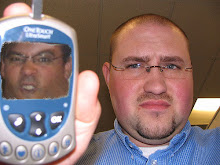So What Really Happened?
 Take a look at that nice flat line staying in my target range for hours on end. Doesn't that look nice? I mean, what more could you ask for??
Take a look at that nice flat line staying in my target range for hours on end. Doesn't that look nice? I mean, what more could you ask for??How about an accurate reflection of what really happened with my blood sugar.
As I looked at the second test in that series, I just knew that it was not a very accurate picture of what really happened. I had a large meal shortly after the first test, so I just know that it spiked up shortly after.
I think that this is a perfect example of why finger pokes only catch a small amount of what really happens. Think about the charts that Wil showed from his Guardian RT CGMS system, with the wild up and down all over the place route that our blood sugar takes through the course of it's day, showing how things really are. Or at least a better, more accurate picture of what really happens.
So what did I miss? I colored in a line that might better show what happened, or at least a guess at it. How can I really know with just finger sticks?



3 Comments:
Hi Scott,
That's what I want to know...so we inject insulin to counteract the carbs we've just eaten. I was told to inject approx. 15 minutes before the meal so it has a chance to enter the system. Shouldn't our numbers then be a steady line as the insulin does its job? Or do they increase astronomically and it is our hope that it declines to under 140 two hours after the meal?
What happens in a non-diabetic person? Can they eat all the tootsie rolls they want and their level will remain a steady 88/mg? My husband has refused to be my guinea pig for testing...
Scott,
Joseph tests 12-14 times per day-- sometimes more (we actually check him overnight while he sleeps-- usually every 2-3 hours).
And his smart charts often resemble the colored line you've drawn here. Though the spikes vary in height-- sometimes just outside of normal; at others, very much so.
Regardless, there are still almost always post-meal spikes (FYI-- his endo is unconcerned by this, as Joseph usually comes down nicely by the 4-hr mark... but still, those spikes can't be good).
I can only imagine what we would see if he were wearing a CGMS. And really, how we would use this information without over correcting (Don't get me wrong. I WANT a CGMS-- more than anything else, to catch the lows before he crashes.)
Ah well.
In the meantime, Sweetsnomo has got me curious about post-food spikes (or lack there of) in non-diabetics... hmmm...
Good golly, man. I know that CGMS will give us greater insights, but until then I think we should test frequently be proud of any straight lines we can muster that remain in the target range.
When you compare this day with the wacko ones that aren't straight, you get at least a feel for how things are going on a relative basis, right?
Sure, we can always use more information. (I'm a data addict myself.) But the very fact that you are doing this sort of charting is excellent in my view.
Post a Comment
Subscribe to Post Comments [Atom]
<< Home